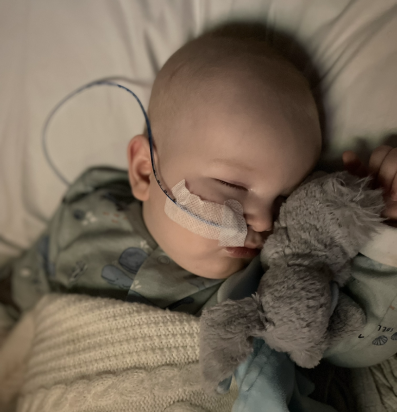
Together against RSV
Welcome to the RSV Hub. Here you can learn more about respiratory syncytial virus (RSV), the illnesses it causes and associated symptoms.
This hub is for the UK general public and is part of the Together Against RSV disease awareness initiative, created and funded by Sanofi.
Respiratory Syncytial Virus (RSV), pronounced “sin-si-tial”, is a common and contagious virus that affects nearly all children by the time they are two years old.1
The other most commonly detected viruses that can also cause respiratory illness in babies include rhinovirus and influenza virus.2
The Together Against RSV Campaign
Findings from a survey organised and funded by Sanofi have shown that despite RSV affecting nearly all children by the time they are two, over half of parents haven't heard of RSV, or only know the name.1,3 The Together Against RSV campaign is a disease awareness initiative from Sanofi that aims to rectify this disconnect by educating and informing parents, expectant parents, and caregivers about RSV.
Research from a new report by RAND Europe and Cambridge University shows the UK societal and economic impact of RSV in children under 5.
The report presents the following concerning stats:4
£14 million in lost productivity of parents and carers
£1.5 million out-of-pocket costs incurred by parents and carers
£65 million of healthcare costs
There are around 467,000 visits to GPs (primary care physicians)
and 34,000 hospitalisations each year in the UK due to children under 5 being ill with RSV
Making the total economic cost an estimated £80 million each year
Watch this video to learn more about the signs and symptoms of RSV-related illnesses and steps you can take to help protect your baby

RSV infections
Most RSV infections in babies are mild and clear up on their own within a few weeks, however, some cases can be more serious.5
In the UK, there are approximately 30,000 babies and children under five hospitalised every year due to RSV.6 Croup, bronchiolitis, and pneumonia are examples of severe illnesses that can be caused by RSV.7

Who is at risk?
All infants are at risk of RSV.1 While most infections cause mild, cold-like symptoms,8 it's important to be aware of RSV and understand how to spot the more severe symptoms.
With the right information, parents, parents-to-be and caregivers can feel better prepared, reducing worry or stress at a time when life can be stressful enough.

How to prevent RSV
There are precautions you can take to help protect your baby from RSV. These are the same steps you might take to prevent other common viral infections like:9,10
- Washing hands frequently for 20 seconds
- Keeping your hands away from your face
- Disinfecting surfaces and toys
- Avoiding close contact with others who may be showing symptoms
The nationwide Together Against RSV survey of 1,500 parents unveiled the burden RSV can have, including on parents' mental health, day-to-day life, family life and even work and finances. It also showed that parents lack adequate RSV understanding and information.
So, through provision of expert endorsed educational information, initiatives and resources, the Together Against RSV campaign will help parents to learn about RSV, including becoming more aware of the signs and symptoms, which could help reduce the impact of RSV on parents and in turn, pressure on healthcare systems.

“I would have loved to have known what to look out for, and that my baby sucking his stomach in whilst breathing was an indicator of RSV related illness”
Carrie-Anne, parent of a child with RSV
“The RSV burden on parents could be greatly alleviated through a better understanding of what RSV is, what the symptoms to look out for are and when and where to seek help,”
Professor Harish Nair, Chair of Paediatric Infectious Diseases and Global Health at the University of Edinburgh.
Together Against RSV is a disease awareness initiative organised and funded by Sanofi that aims to educate and inform the public about respiratory infections in infants caused by respiratory syncytial virus (RSV).
References
- World Health Organization. WHO preferred product characteristics for respiratory syncytial virus (RSV) vaccines. [Online] Available at: https://www.who.int/publications/i/item/WHO-IVB-17.11 [Accessed November 2023]
- NHS. Guy's and St Thomas's Trust. Your child's respiratory virus infection and how we manage it. [Online] Available at: https://www.evelinalondon.nhs.uk/resources/patient-information/respiratory-virus-infection-control.pdf [Accessed November 2023]
- Toluna 2022 Survey. Data on file
- RAND Report. The impact of respiratory syncytial virus on the NHS, society and economy in the UK. [Online] Available at: https://www.rand.org/randeurope/research/projects/impact-of-respiratory-syncytial-virus.html [Accessed November 2023]
- Babycentre. Respiratory syncytial virus (RSV). [Online] Available at: https://www.babycentre.co.uk/a25022968/respiratory-syncytial-virus-rsv [Accessed November 2023]
- Oxford Vaccine Group. Respiratory syncytial virus. What is respiratory syncytial virus (RSV)? [Online] Available at: https://vk.ovg.ox.ac.uk/vk/rsv [Accessed November 2023]
- UK Government. Guidance. Respiratory syncytial virus (RSV): symptoms, transmission, prevention, treatment. [Online] Available at: https://www.gov.uk/government/publications/respiratory-syncytial-virus-rsv-symptoms-transmission-prevention-treatment/ [Accessed November 2023]
- Asthma + Lung UK. Signs of breathing problems in children. How to spot respiratory tract infections in children. [Online] Available at: https://www.asthmaandlung.org.uk/conditions/signs-breathing-problems-children/how-spot-respiratory-tract-infections-children [Accessed November 2023]
- Cleveland Clinic. Respiratory Syncytial Virus (RSV). [Online] Available at: https://my.clevelandclinic.org/health/diseases/8282-respiratory-syncytial-virus-in-children-and-adults [Accessed November 2023]
- Welsh Government. Respiratory syncytial virus (RSV) and bronchiolitis. [Online] Available at: https://gov.wales/sites/default/files/publications/2021-10/respiratory-syncytial-virus-rsv-and-bronchiolitis-leaflet.pdf [Accessed November 2023]

